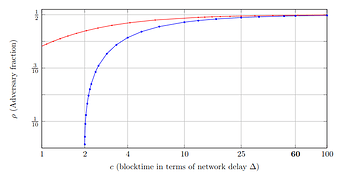The variance can be modeled and will show a shorter block time will still have variance but will have less. The number of seconds required to produce i blocks falling below the target pow is distributed as Gamma(i, b) where b is the expected number of blocks per second.
Using a two chain example that only differ in target block time; 1 block every 600s is modeled with Gamma(1, 1/600) while 10 blocks every 600 seconds is Gamma (10, 1/60). Now take random variables X1 ~ Gamma(1, 1/600) and X10 ~ Gamma(10, 1/60). Since the mean and the variance of a random variable with distribution Gamma(i,b) are i/b and i/b**2, we know that expected X1 / expected X10 = 1. however variance X1 / variance X10 = 100.
The variance of process X1 is 100 times greater than of X10 when they are both calibrated to run for 10 minutes.
To summarise in English… given two identical chains except for block time with identical network hash rates, both chains will meet some expected PoW target of security at the same time on average. However, the chain with a shorter target block time will have fewer exceptional cases where the pow target is met late. So while harbinger is right, there is nothing to prevent exchanges from 4x or 5x the number of confirmations required because the pow target is now 1/4 or 1/5 what it once was, the time to meet the pow target will be more consistent than it was before with the longer block times.
TLDR; More blocks in the same amount of time (shorter target block time) leads to a tighter distribution of block times.
Also keep in mind that as the block time gets shorter, orphan rate will go up. not providing any math on that right now but i believe we all generally know this to be true.
All that being said, it is probably not worth the cost to hardfork only to reduce the target time of full blocks. Better to fork to add in some other inter-full-block scheme such as weakblocks/bobtail/tailstorm. or both. but not only the full block target time reduction.

